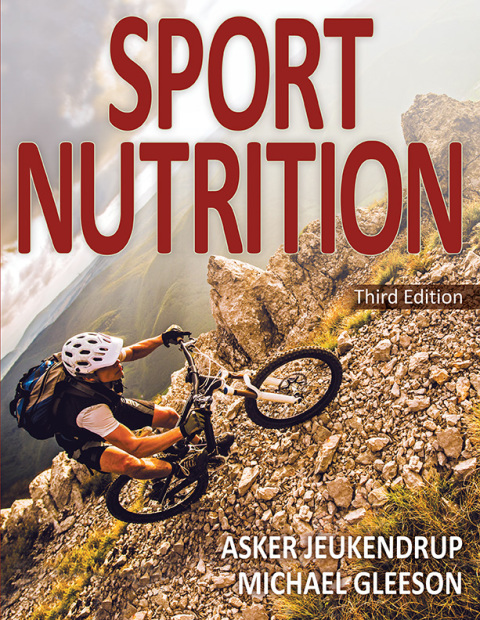Description
Efnisyfirlit
- Cover
- Title Page
- Copyright
- Dedications
- Contents
- Preface
- Acknowledgments
- Chapter 1. Nutrients and Recommended Intakes
- Function of Nutrients
- Carbohydrate
- Fat
- Protein
- Water
- Alcohol
- Vitamins, Minerals, and Trace Elements
- Phytonutrients
- Recommended Intakes of Nutrients
- Development of Recommended Intakes
- Current Recommended Intakes
- Analyzing Dietary Intakes
- Chapter 2. Healthy Eating
- Health Effects of Consuming Excess Nutrients
- Practical Guidelines for a Balanced, Healthy Diet
- Recommendations for a Healthy Diet and Lifestyle
- Nutrition Facts Labels
- Nutrient Content and Health Claims on Food Packaging
- Processed Foods and Additives
- Fat Substitutes
- Chapter 3. Fuel Sources for Muscle and Exercise Metabolism
- Subcellular Skeletal Muscle Structure
- Force Generation in Skeletal Muscle
- Fiber Types
- Energy for Muscle Force Generation
- Fuel Stores in Skeletal Muscle
- Regulation of Energy Metabolism
- Metabolic Responses to Exercise
- Metabolic Adaptations to Exercise Training
- Chapter 4. Energy
- Energetic Efficiency
- Measuring the Energy Content of Food
- Measuring Energy Expenditure
- Components of Energy Expenditure
- Energy Balance
- Chapter 5. Gastric Emptying, Digestion, and Absorption
- Anatomy of the Gastrointestinal Tract
- Regulation of the Gastrointestinal Tract
- Digestion
- Absorption
- Gut Microbiota
- Regulation of Gastric Emptying
- Gastrointestinal Problems During and After Exercise
- Chapter 6. Carbohydrate
- History
- Role of Carbohydrate
- Recommendations for Carbohydrate Intake
- Carbohydrate Intake in the Days Before Competition
- Carbohydrate Intake in the Hours Before Exercise
- Carbohydrate Intake 30 to 60 Minutes Before Exercise
- Carbohydrate Intake During Exercise
- Carbohydrate Intake After Exercise
- Chapter 7. Fat
- Fat Metabolism During Exercise
- Limits to Fat Oxidation
- Fat as a Fuel During Exercise
- Regulation of Carbohydrate and Fat Metabolism
- Fat Supplementation and Exercise
- Effects of Diet on Fat Metabolism and Performance
- Chapter 8. Protein and Amino Acids
- Amino Acids
- Techniques to Study Protein and Amino Acid Metabolism
- Protein Requirements for Exercise
- Training and Protein Metabolism
- Effect of Protein Intake on Protein Synthesis
- Amino Acids as Ergogenic Aids
- Protein Intake and Health Risks
- Chapter 9. Water Requirements and Fluid Balance
- Thermoregulation and Exercise in the Heat
- Effects of Dehydration on Exercise Performance
- Mechanisms of Heat Illness
- Effects of Fluid Intake on Exercise Performance
- Daily Water Balance
- Fluid Requirements for Athletes
- Chapter 10. Vitamins and Minerals
- Water-Soluble and Fat-Soluble Vitamins
- Recommended Intakes of Vitamins
- Recommended Intakes of Vitamins for Athletes
- Macrominerals and Microminerals
- Recommended Intakes of Minerals
- Critical Micronutrient Functions
- Assessing Micronutrient Status
- Exercise and Micronutrient Requirements
- Ergogenic Effect of Micronutrient Supplementation
- Summary of Recommendations for Micronutrient Intake in Athletes
- Chapter 11. Nutrition Supplements
- Relative Importance of Supplements to a Normal Diet
- Nonregulation of Nutrition Supplements
- Critical Evaluation of Nutrition Supplement Studies
- Androstenedione
- Bee Pollen
- Beetroot Juice
- ß-Alanine and Carnosine
- ß-Hydroxy ß-Methylbutyrate
- Boron
- Caffeine
- Carnitine
- Cherry Juice
- Choline
- Chromium
- Coenzyme Q10
- Creatine
- Dehydroepiandrosterone
- Fish Oil and Omega-3 Fatty Acids
- Ginseng
- Glandulars
- Glycerol
- Green Tea
- Inosine
- Ketone Salts
- Lactate Salts and Polylactate
- Lecithin
- Medium-Chain Triacylglycerol
- Pangamic Acid
- Phosphatidylserine
- Phosphorus and Phosphate Salts
- Polyphenols
- Pyruvate and Dihydroxyacetone
- Sodium Bicarbonate
- Sodium Citrate
- Sodium Nitrate
- Vanadium
- Wheat Germ Oil
- Additive Effects of Combining Different Supplements
- Contamination of Nutrition Supplements
- Chapter 12. Nutrition and Training Adaptations
- Training Adaptations
- Signal Transduction Pathways
- Starting a Signaling Cascade
- Secondary Signals
- Nutrition and Effects on Training Adaptations
- Overreaching and the Overtraining Syndrome
- Nutrition and Effects on Sleep
- Nutrition and Effects on Rehabilitation
- Chapter 13. Nutrition and Immune Function in Athletes
- Functions of the Immune System and Its Cellular Components
- General Mechanisms of the Immune Response
- Causes of Illness in Athletes
- Effects of Exercise on the Immune System
- Nutritional Manipulations to Decrease Immunodepression in Athletes
- Conclusions and Recommendations
- Chapter 14. Body Composition
- Optimal Body Weight and Composition
- Body Composition Models
- Normal Ranges of Body Weight and Body Fat
- Body Composition Measurement Techniques
- Chapter 15. Weight Management
- Genetics
- Energy and Macronutrient Intake
- Regulation of Appetite
- Effect of Exercise on Appetite
- Physical Activity and Energy Expenditure
- Dietary Weight-Loss Methods
- Exercise for Weight Loss
- Decreased Resting Metabolic Rate With Weight Loss
- Weight Cycling
- Gender Differences in Weight Loss
- Practicalities of Weight Loss for Athletes
- Weight Gain
- Chapter 16. Eating Disorders in Athletes
- Types of Eating Disorders
- Prevalence of Eating Disorders in Athletes
- Effects of Eating Disorders on Sports Performance
- Effects of Eating Disorders on Health
- Treatment and Prevention of Eating Disorders
- Chapter 17. Personalized Nutrition
- Genetic Influences
- Turning Science Into Practice
- Specific Populations
- Nutrition Application in Different Sport Situations and Populations
- Appendix A: Key Concepts in Biological Chemistry Relevant to Sport Nutrition
- Appendix B: Unit Conversion Tables
- Appendix C: Recommended Daily Allowances for North America
- Appendix D: Reference Nutrient Intakes for the United Kingdom
- Appendix E: Recommended Dietary Intakes for Australia and New Zealand
- Glossary
- References
- Index
- About the Authors







Reviews
There are no reviews yet.